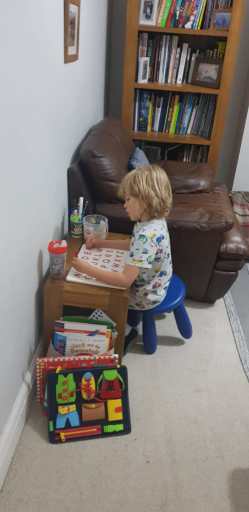Rhys sat on the floor, his balance bike in front of him, on its side, the wheels spinning.
I looked at the bike, with an image in my mind, of him sitting on the seat, his legs pushing off the ground as he glided down the small path at the top of our road. An image I had seen of other children his age, while out with their family. High pitch screams of excitement as they felt the warm air glide through their hair.
Rhys however continued to sit and spin.
I knew he was happy, to him moving wheels was just the best thing ever. But somewhere in my heart, I wanted him to enjoy the movement of the bike and the feeling of freedom, it taking him on an adventure.
I consulted Google for advice, and there were a few printouts about riding a bike. They were structured into a number of pictures which sequentially formed a story, with a beginning, middle and end. The social story around the activity seemed like a good idea, so I printed it out and arranged it ready to show Rhys.
Bending down to his level, I held up a picture of a little boy. He was wearing his helmet, with the words ‘ride my bike’ stencilled in bold above the image. “Rhys, ride bike?” I asked.
Rhys’ eyes remained transfixed on the movement of the wheels, ensuring their continuous motion with a swift flick of his hand every time they started to slow down.
He did not acknowledge my picture.
I held up the second picture in the sequence. The boy was now climbing onto the bike, the words ‘sit on seat’ stencilled once again in bold above the image. “Rhys sit on bike?” I asked, taking the bike in my hands and lifting it up onto its wheels.
My social story suddenly took a different turn. Rhys got angry! His wheels had stopped moving. His fun had ended with no explanation except for some crazy woman holding up pieces of unrelated paper! He pulled the balance bike towards him, letting it fall back onto the floor. Lifting his hand he spun the wheel once again, and watched it move.
No fancy social story printed off the Internet was going to work. I realise that I would need to accept that objects didn’t necessarily need to be used in he way they were advertised.
Later that day we sat watching Peppa Pig. She was on the way to the dentist, every step of her journey described in her own little bossy way. The journey in the car, the waiting room, the dentist’s chair – it was all methodically described, with a happy ‘jump in muddy puddles’ ending.
I had an idea.
I grabbed my phone and searched. It didn’t take long, but I found a Peppa Pig episode where the family went on a bike ride. They had a race, they had fun while seated on their bikes.
I put the episode on the telly and we watched it on repeat. Then I searched YouTube and found a video of a little boy on his balance bike. I played the clip in the background as Rhys spun the wheels on his bike. After a while, I saw his eyes notice the screen, and then start to watch the movement of the bike as the boy rode up and down the road.
Picking up the bike, I placed it in front of Rhys, and he reluctantly sat on the seat as I pushed him over the carpets and around the house.
He rode his bike just like Peppa, just like the little boy on YouTube.
A social story does not need to be a paper sequence of pictures. It can be anything to describe and explain an activity or social norm. Being in the technology age, I used the device at the end of my finger tips. A hub of resources just waiting for a search term.
We still have a long way to go on the bike. But we will take one step at a time. Thanks to Peppa, she got us one step forward.
🚲🚲🚲🚲🚲🚲🚲🚲🚲
Read about social stories and how to use them here.
Let me know your thoughts. Go to Facebook and comment if you have tried any strategies. Share so others can try them too.










